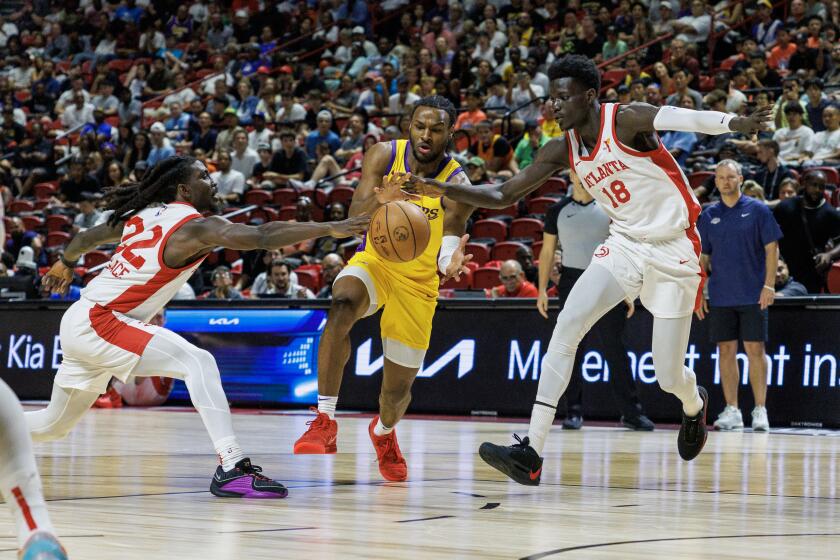Going Against the Grains
Viewed from afar, it looks like a tidal wave of sand rising precipitously and ominously over a leafy neighborhood.
Up close, its verticality may be even more impressive.
The sheer face of golden granules at Sand Dune Park in Manhattan Beach seems to stretch to the sky, an enticing welcome mat for exercise junkies looking to spike their heart rates while churning their screaming legs through the dune’s ever-shifting mass.
Not surprisingly, a long list of elite athletes shows up.
In recent weeks, for instance, a visitor to the dune might have encountered Troy Polamalu of the Pittsburgh Steelers, Andrew Bynum of the Lakers or former UCLA defensive back Kirk Alexander, a phenomenally fit personal trainer who spends so much time there that he is known as “King of the Dune.”
Kobe Bryant has trained at Sand Dune Park, as have several of his Lakers teammates, past and present. Paul Pierce of the Boston Celtics, Tony Gonzalez of the Kansas City Chiefs and any number of NHL players, USC and UCLA football players, volleyball players, boxers, fighters, sprinters and WNBA players also have taken on the dune, sharing the sand with a steady stream of weekend warriors.
Some run up the hill. Others walk. Some sprint back down. Others take the nearby stairs. The more experienced and fit seem to effortlessly glide to the top. Others slog laboriously. Some consider three or four times up and down an adequate workout. Others may repeat the drill as many as 40 times. Some walk away afterward seemingly refreshed. Others are nauseated, hunched over a trash can.
At the least, all wind up with streams of sweat rolling down their cheeks.
“If you can master it, you’re ready for anything,” said Alexander, whose client roster has included Polamalu and former Lakers forward Cedric Ceballos. “You tend to be faster, fitter.”
In the early 1990s, when Loyola Marymount’s basketball teams ran tirelessly up and down the floor while setting numerous NCAA scoring records, coach Paul Westhead brought them to Sand Dune Park for early-season training.
“It’s a serious endurance game,” personal trainer Joe Charles said of the dune, which is about 100 yards long, 50 yards wide and steeped at about a 45-degree angle. “Most people, when they get up there that first time, they’re like, ‘Oh ... my ... God!’ and they hesitate about doing it again. You’ll find that a lot of your professional athletes conquer it and then want to come back and conquer it again and again because it’s challenging -- very, very challenging.”
Said former USC tailback and sprinter Sultan McCullough, a longtime dune devotee: “It’s the only workout that can make me throw up.”
Holly McPeak, an Olympic medalist in women’s beach volleyball and a lifelong Manhattan Beach resident, remembers a time when climbing to the top of Sand Dune Park was practically a solitary experience.
“Maybe one or two other people would be up there,” she said.
Those days are long past.
Tucked into a neighborhood of million- and multimillion-dollar homes in the city’s Tree Section, only a few blocks from the ocean but on the opposite side of a hill from the water, the dune draws athletes from far and wide. Opened as a park in 1964, it is the only remaining area of the city that resembles the original topography of Manhattan Beach, which 80 years ago exported sand to Hawaii to replenish Waikiki Beach.
For years it was a local secret, but the park’s popularity has grown so vast in recent years that homeowners in the adjacent neighborhood, rankled by a burgeoning influx of the physically fit, have been successful in lobbying the city for tighter restrictions on the park’s use, mostly relating to noise and littering.
City officials don’t like to talk about the park, for fear that stories about it will only add to its allure and rally neighbors to try to shut it down.
“Any kind of publicity increases the use and could lead to something negative,” said Idris Jassim Al-Oboudi, recreation services manager, adding that the city is trying to manage the demand. “My job is to keep that park open.”
Rain or shine, the dune is rarely without visitors.
Four times a year, the sand having fanned out from repeated churning, the park is closed for the better part of a day while the dune is replenished. Sand is scooped from the bottom, loaded into dump trucks and carried through the neighborhood to the top, where it is dumped to be shifted anew.
“Overall, it’s a great workout,” said Nono, who trains jiu-jitsu competitors at his studio in neighboring Hermosa Beach, among them former Ultimate Fighting Championships kingpin Royce Gracie, and incorporates dune training into their regimen. “It’s Mother Nature sitting there telling you, ‘Come here, let me help you.’ ”
Of course, not everybody views it that way initially.
“The first time you see the dune, it’s pretty intimidating,” said Joe Carbone, a Lakers strength and conditioning coach. “It’s very steep and seems very long, like it goes on forever. And it’s sand, so it’s tough to get through it.”
McPeak knows about that.
“The harder you push, the further down you sink,” she said, “so you have to be very explosive. And when you get about halfway up it gets deeper and steeper, and it seems like you really hit a wall. It’s hard to get past that.”
But get past it they do.
Time and again.
Up and down.
What is it that keeps them running up that hill?
“It’s tough, it’s hard work and these guys like a challenge,” Carbone said. “I think that’s part of their competitive nature.”
More to Read
All things Lakers, all the time.
Get all the Lakers news you need in Dan Woike's weekly newsletter.
You may occasionally receive promotional content from the Los Angeles Times.




